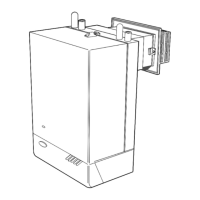5. With the system HOT, examine all water connections for
soundness. Then turn OFF the gas, electricity and water
supplies to the appliance and drain down whilst the system
is still hot, in order to complete the flushing process. Refill
and vent the system and again check for water soundness.
6. Finally, set the controls to the User's requirements.
The temperatures quoted below are approximate and vary
between installations.
Knob Setting Flow Temperature
o
C
o
F
1 56 133
2 61 142
3 66 152
4 72 161
5 77 170
6 82 180
14
INSTALLATION
COMMISSIONING AND TESTING
25 GENERAL CHECKS
Make the following checks for correct operation:
1. Turn the boiler thermostat OFF and ON, and check that
the main burner is extinguished and relit in response.
2. Flame failure device
Check the operation of the flame failure device in the
gas control valve as follows:
(a) Extinguish the pilot flames by closing the gas service
cock (H) and note the time taken for the flame failure
device to shut down - identified by a click within the gas
control valve. This MUST NOT be longer than
50 seconds.
(b) Open the gas service cock and relight the pilot.
3. With the burner alight again, slide the gas control button to
the right until resistance is felt and then release it. The
burner and pilot flames should shut down immediately.
Note: A latch in the gas control provides a safety delay
period before the boiler can be relit.
4. The correct operation of ANY programmer and all other
system controls should be proved. Operate each control
separately and check that the main burner or circulating
pump, as the case may be, responds.
WARNING. The boiler MUST NOT be operated with the casing removed.
26 HANDING OVER
After completing the installation and commissioning of the system, then the installer should hand over to the
householder by the following actions:
1. Hand the User's Instructions to the Householder and
explain his or her responsibilities under the Gas Safety
(Installation and Use) Regulations 1984.
2. Draw attention to the Lighting Instruction label affixed to
the controls pod door.
3. Explain and demonstrate the lighting and shutting down
procedures.
4. The operation of the boiler and the use and adjustment of
ALL system controls should be fully explained to the
Householder, to ensure the greatest possible fuel
economy, consistent with household requirements of both
heating and hot water consumption.
Advise the User of the precautions necessary to prevent
damage to the system and to the building, in the event of
the system remaining inoperative during frosty conditions.
5. Explain the function and the use of the boiler thermostat
and external controls.
6. Explain the function of the boiler overheat thermostat
(ONLY FITTED FOR SEALED SYSTEM USE) and
emphasise that if cutout persists, the boiler should be
turned off and the local heating installer consulted.
7. Explain and demonstrate the function of time and
temperature controls, radiator valves etc., for the
economic use of the system.
8. If any Programmer Kit is fitted, then draw attention to the
Programmer Kit User's Instructions and hand them to the
Householder.
9. Stress the importance of regular servicing by the local
gas region or by a qualified heating engineer and that a
comprehensive service should be carried out AT LEAST
ONCE A YEAR.

